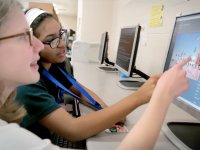Discover, Mashup, and Share Smithsonian Collections – for Free
Take virtual field trips to visit student- and teacher-created collections of museum objects with a new online learning platform.
Your content has been saved!
Go to My Saved Content.When the Smithsonian wanted to find out how to best leverage digital museum resources to make them relevant for classroom learning, what did they do? They asked teachers. The resulting effort is the Smithsonian Learning Lab, a flexible, online, research-informed learning platform that launched in public beta in autumn 2015.
The new tool makes it easy for educators and students of all ages to create and share digital collections of museum objects -- including 1.35 million images, as well as recordings and texts -- as a vehicle for or supplement to authentic, meaningful, and personalized learning experiences.
Students and teachers can use these online tools to:
- Search for and view items within the database. In addition to information about the object such as background, source, creation dates, etc., students can also view photos of objects, videos, sound recordings, and other assets.
- Group any number of objects into collections, edit and annotate each item, and give those collections names.
- Attach tools to items within collections such as discussions, maps, standards, quizzes, etc.
Browse museum objects online or sign up to get started building your own collections. For highlights, ideas, and examples, a few sample activities, collections, and digital objects are linked below.
Sample Activities
Lesson Ideas
Ready, Set, Design! (Grades 9-12): For this challenge from Cooper Hewitt, students were asked to design a chair to be functional, comfortable, and unexpected. Twelve Cooper Hewitt collection objects were offered up as inspiration to student designers, including this 1928 sugar bowl and creamer and this ashetu hat from Cameroon. Check out some of the student and educator resources from the challenge, including a chair design lesson plan.
Using Realia to Teach English Language Learners (Grades K-12): Help students learn vocabulary in context by using images of different shoes in the Smithsonian collections to inform descriptive or compare-and-contrast conversations, encourage students to make personal connections, or explore the history of objects.
Giving Tangibility to Mathematics (Grades K-8): As the two lessons in this issue of Smithsonian in Your Classroom demonstrate, explorations of art, history, and science collections can help young students make connections between numbers on a page and physical things.
Space Suit Challenge (Grades 9-12): Students could explore the evolution of space suit design via museum images and recordings as a lead-in to designing their own space suit prototype.
Collections Created By Teachers
Animal Adaptations: Beaks (Grades K-2): Created by a first grade teacher, this collection focuses on a variety of bird beaks and their functions.
Ancient Egypt: a Variety of Artifacts (Grades K-12): A middle school teacher assembled this collection of ancient Egyptian artifacts that can be used in the context of student research projects.
The Art of Writing and Calligraphy (Grades K-12): Former high school teacher Kate Harris assembled this compilation representing styles of writing from around the world.
More From Edutopia About Open Education Resources and Virtual Field Trips
- How to Engage Your Students With No-Cost Technology (2015)
- 5-Minute Film Festival: Virtual Field Trips (2015)
- Travel the World From Your Classroom: Free iPad Apps for Virtual Field Trips (2014)
- Open Educational Resources (OER): Resource Roundup (2015)
- Teaching With Web-Based Resources (2015)
- 20 Top Pinterest Tips (2015)
The Smithsonian collections are growing -- they say a new object is digitized every six seconds. I’m excited to watch this project evolve. How might you make use of objects from the collections in your classroom? We’d love to hear your ideas in the comments.
